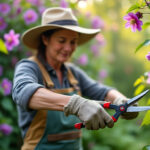Wisteria, with its stunning, cascading blooms and vigorous growth, can be an astonishing addition to any garden. However, without proper care and attention, this majestic vine can quickly transform into an overwhelming mass of greenery. Understanding the essential practices of pruning is vital to ensuring optimal growth, magnificent displays of flowers, and the overall health of Wisteria plants. This article serves as a thorough guide covering various aspects of wisteria pruning throughout different seasons, techniques, and the significance of this practice for thriving gardens.
- Understanding Wisteria Growth Cycles and Types
- When to Prune Wisteria for the Best Results
- Effective Techniques for Pruning Wisteria
- Training Wisteria for Desired Growth Patterns
- Common Questions and Answers About Wisteria Pruning
Understanding Wisteria Growth Cycles and Types
Wisteria is renowned for its beautiful flowering structure, growing as a woody vine that can reach great heights and widths if left unchecked. The plant exhibits two primary types of growth: lateral shoots, which produce the magnificent blooms, and spurs that emerge from these lateral shoots. Each type serves a unique purpose in the plant’s lifecycle and requires different pruning considerations.
The vigorous nature of wisteria can be attributed to its long, vigorous growth during the growing season. This growth is characterized by robust lateral shoots that may spread uncontrollably without intervention. Meanwhile, the spurs are essential for blooming, as they produce the flower buds that appear in spring. Understanding these growth habits is critical to implementing successful pruning strategies.
Moreover, wisteria is deciduous, which means it loses its leaves during part of the year, typically in late autumn. This dormancy phase is crucial when planning pruning activities, as it allows for easier visibility of the vine’s structure, enabling precise cuts during the pruning process. Two primary pruning sessions are vital for maintaining optimal health and appearance, and understanding their timing and purpose is fundamental.
Types of Pruning: Lateral Shoots and Spurs
When discussing pruning wisteria, it is essential to distinguish between the growth types that require different pruning strategies. The proper handling of lateral shoots and spurs directly influences the flowering potential of the plant.
- Lateral Shoots: These elongated branches produce the stunning blossoms. They thrive when allowed to grow freely but require careful management to avoid overwhelming the structure they cling to.
- Spurs: These shorter stems are developed from lateral shoots and vital for flowering. Managing these spurs is necessary to encourage the fading bloom heads to regenerate for the following season.
When to Prune Wisteria for the Best Results
Timing plays a fundamental role in the successful pruning of wisteria. Typically, two essential pruning periods throughout the year are recommended, ensuring the vine retains its vigor and blooms abundantly. The specific months for pruning will yield different results concerning the overall growth and flowering outcomes.
The initial pruning session should occur in late winter, ideally February. During this time, the vine is dormant, allowing for easier assessment and cleanup. A proper winter prune prepares the plant for the upcoming growing season, wrapping up any potential tangling of the stems. This period also permits necessary maintenance on the supporting structures, ensuring that repairs are executed without the burden of leaves. A well-maintained support structure combined with careful winter pruning ensures a stable environment for the vine to grow healthily.
Mid-Summer Pruning
Following the winter prune, a mid-summer pruning session should take place around July or August, shortly after the flowering season. Once the initial blooms have faded, the vine will shift its energy toward new growth. Summer pruning is crucial for managing the overall size and potential of the vine—preventing a chaotic tangle that can obscure windows and structures it climbs.
This pruning session allows gardeners to control and direct the new growth while enhancing flowering opportunities for subsequent seasons. The meticulous task involves cutting back excessively long branches, tidying the plant while encouraging flower production for the next season.
| Pruning Type | Timing | Purpose |
|---|---|---|
| Winter Pruning | Late Winter (February) | Shape the plant, remove dead wood, prepare for growth |
| Summer Pruning | Mid-Summer (July-August) | Manage size, encourage new growth, improve flowering |
Effective Techniques for Pruning Wisteria
Utilizing the right techniques is critical when it comes to the successful pruning of wisteria. Employing sound practices ensures that the plant not only thrives but also showcases its spectacular blossoms each year. This essential process can be broken down into manageable steps throughout the winter and summer pruning sessions.
Winter Pruning Techniques
- Begin by inspecting the plant for dead or diseased wood, ensuring that all broken or lifeless branches are removed to maintain plant health.
- Trim back newly grown branches from the last season to a length of about 3-4 buds, promoting future flowering while controlling size.
- Identify and remove any congested stems, ensuring adequate air circulation to encourage vibrant foliage and blooms.
Summer Pruning Techniques
- Cut back excessive lateral growth by about half its length, which promotes bushier growth and enhances flowering potential.
- Remove any unwanted growth at the plant’s base to concentrate energy toward developing the primary structure of the plant.
- Maintain periodic checks throughout the summer, pruning out any stems that threaten to overshadow the desired form.
These pruning practices, if executed consistently, contribute significantly to creating a healthy, thriving environment for wisteria. Furthermore, they maximize bloom brilliance, ensuring stunning visual displays that highlight the landscape beautifully.
When to harvest broccoli for the best taste and nutrition
Training Wisteria for Desired Growth Patterns
In addition to pruning, training wisteria is crucial for encouraging its growth along specific paths and structures. Training methods can include espalier, arching, or standard growth, allowing the gardener to dictate the vine’s form and interaction with its environment.
Espaliering involves attaching the main stems to flat surfaces like walls or trellises, making it an ideal method for smaller yards or specific decorative purposes. This method utilizes the wall surface to expand the vine while displaying beautiful blooms evenly across a section.
Arching creates stunning archways by guiding the primary growth to curve gracefully over pergolas and arches. This method transforms shared spaces to breathtaking visual experiences. Meanwhile, standard training involves selecting a single stem to train upward into a tree-like structure, removing all lateral shoots. Achieving this requires consistent supervision and guidance of the chosen leader stem.
| Training Method | Description | Advantages |
|---|---|---|
| Espalier | Training along flat surfaces | Ideal for small spaces, neat appearance |
| Arching | Creating archways | Aesthetic focal points, maximizes bloom exposure |
| Standard Training | Developing a single vertical stem | Unique visual appeal, controlled size |
Common Questions and Answers About Wisteria Pruning
Addressing common queries regarding wisteria pruning provides beneficial insights for gardeners eager to master this art. Some frequently asked questions include:
FAQ
- How often should wisteria be pruned? Pruning occurs twice a year: once in late winter and once in mid-summer for optimum results.
- Can wisteria be pruned in spring? Spring pruning should be avoided as it can remove potential flower buds and jeopardize the bloom cycle.
- What are the best techniques for stimulating flowering? Both summer and winter pruning are effective in encouraging new flower bud formation.
- How is wisteria size controlled? Regular pruning, specifically trimming back main and lateral growth, helps keep the plant manageable.
- Is it possible to train wisteria into a tree structure? Absolutely! This is achievable by eliminating lateral growth and supporting a single stem.
By mastering the pruning and training methods of wisteria, gardeners can enjoy the delight of abundant blooms and a manicured look to their lush landscapes. Regularly assessing and maintaining the health of the plant fosters vine vitality, making wisteria a magnificent addition to any garden.
















